Contemporary artist Andrea Gregson views her practice as a series of encounters with objects.
Early experiences of objects and wares, ruins, and sites where nature and industry are intertwined, has had a huge impact on my relationship to the material world and is a rich source of inspiration in my work with sculpture.
Contemporary artist Andrea Gregson
Featured image: ‘Crystal Haul’ 2016.
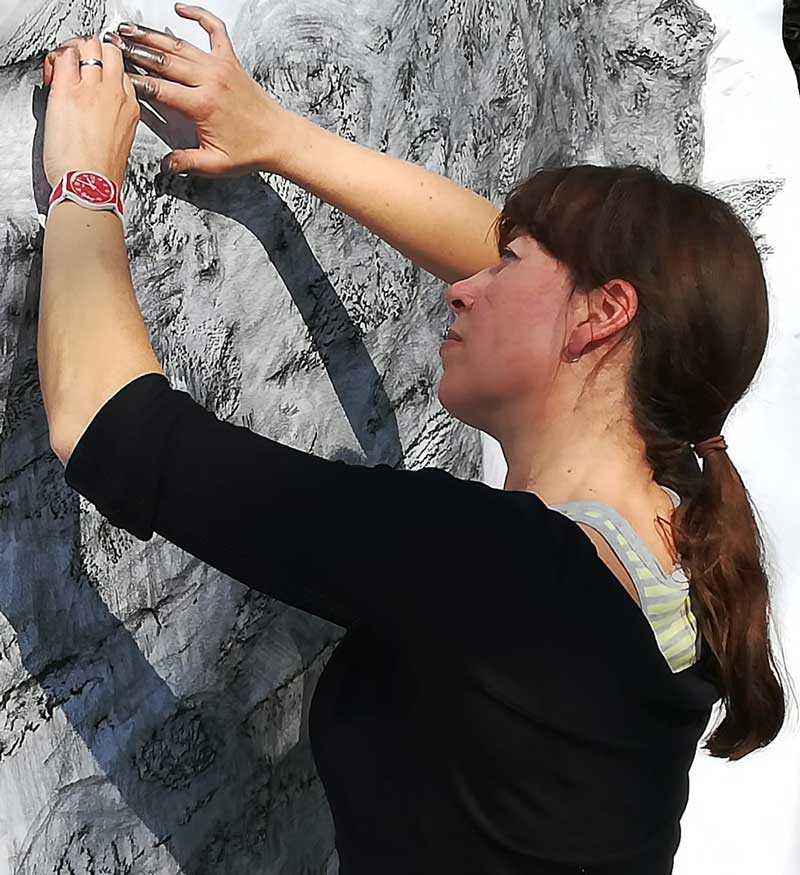
Artist at work. Contemporary artist Andrea Gregson.
How do you describe yourself in the context of challenging people’s perspectives via your work and art?
I’m interested in the agency of objects; the form of things, in the structures shared amongst humans and non-humans alike. The connection between tools and the body interests me greatly. Likewise, I’m drawn to objects found ‘out of time’ and their associated histories gleaned from fragments, in traces and ruins. When working with different materials, objects and spaces it forges new connections to the ‘history of things’ and the way in which they intervene in my own life. I think of the act of making as a means of discovery and knowledge production, posing questions of obsolescence, materiality, value and site. Currently I am making a series of art works that relate to the conflicting relationship between human activity, mass production and nature, making use of sculptural casting processes that radically transform materials to mimic forces in nature.
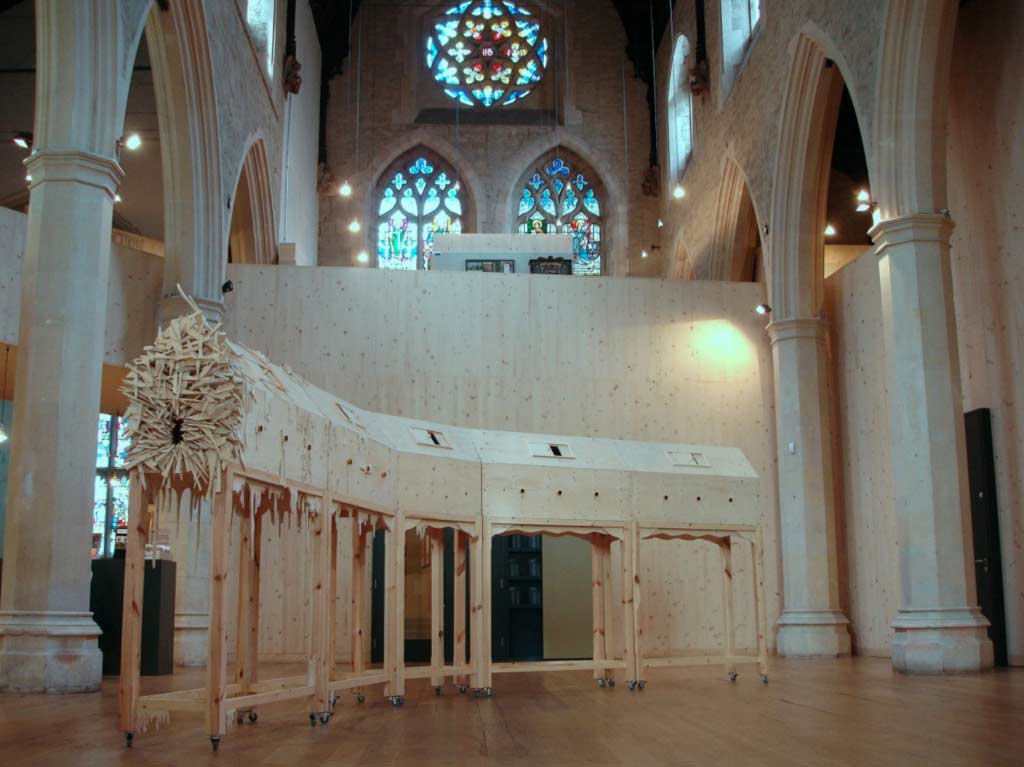
‘Last Night For Ever’, The Garden Museum, 2009. Contemporary artist Andrea Gregson.
How do you deal with the conceptual difficulty and uncertainty of creating new work?
For me drawing is an opportunity to navigate ideas and thoughts in flux. Drawing, alongside improvisation and experimentation with materials and objects, works as a catalyst for ideas to evolve. I use tracing and embossing of structures and surfaces as a way to give a tangible presence to materiality, to create a more haptic understanding of space and time. Drawing excavates ideas in motion, they sometimes lead straight into my sculptural practice be it wood construction, assemblage and casting or it can simply be a great way to resolve problems, visualisation and for making final decisions about materials, scale and logistical questions for larger or more complex pieces of work.
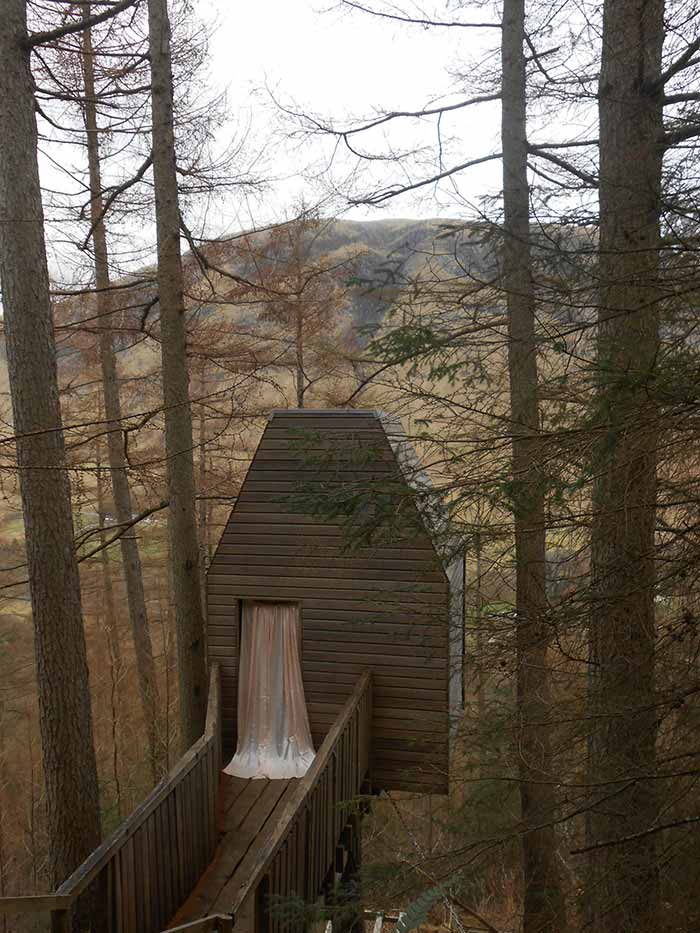
‘Cascade’, Outlandia, Glen Nevis, Scotland 2015. Contemporary artist Andrea Gregson.
I used to construct shell and stone mosaics at the beach, next to the Nuclear Power Station and a WW2 bunker, in this landscape of great juxtapositions I would play in an ancient burial site, the ruined St Patrick’s Chapel over 1000 years old and 8th century rock cut graves set among dramatic geological outcrops.
Contemporary artist Andrea Gregson
Tell us about the evolution of your practice over the years. What would you call your style?
I have always been interested in the object-evolution and the history of things, in their display and materiality. I can trace this directly to my childhood, where I played and worked, in my family’s shop. Started during WW2 by my grandmother, she collected shells from the beach, and made them into gifts, to sell during a time of scarcity. After the war, she sold toys and ornaments, souvenirs for tourists. My mother would make sun-hats, bags, sewing through the winter, to sell in the summer.
The stock room was a curious chaos of objects, a disarray of fragments, post-war glass and brassware, cuckoo clocks, musical boxes, crockery, carved wood figurines, toys, tangled chains and beach ware. Through my eyes as a child, the shop was a kind of Wunderkammer; old stock and new stock, curiosities and throwaways. I used to construct shell and stone mosaics at the beach, next to the Nuclear Power Station and a WW2 bunker, in this landscape of great juxtapositions I would play in an ancient burial site, the ruined St Patrick’s Chapel over 1000 years old and 8th century rock cut graves set among dramatic geological outcrops.
These early experiences of objects and wares, ruins, and sites where nature and industry are intertwined, has had a huge impact on my relationship to the material world and is a rich source of inspiration in my work with sculpture.
These early experiences have made me reflect on how materials have an afterlife, how they adhere to our lives, leaving traces, left in ruins or like fragments scattered above and below ground, inside and outside. Why and how do objects affect us? How does collective matter influence our lives and shape our thinking? I have found that making sculpture is a form of understanding, using the language of things, the different material states, enables new sensations and insights and generate ideas and knowledge beyond language. I am interested in sculptures ability to fold time and space into an object, the intertwining of stories, manufacturing process and the added investment of my labour.

Henry Moore Foundation Residency, Garage space at University of East London, 2016. Contemporary artist Andrea Gregson.
What inspires you? Let’s talk about your frameworks, references and process.
I see my practice as encounters with objects. I seek out collections from; home, my family’s shop, nature, museums, factories and other public spaces. During a residency at Outlandia in 2015, an off-grid artist studio and field-station in Glen Nevis, Scotland, I made some new work made in situ exploring the Anthropocene. Ben Nevis was shaped by water and glaciers and its form is a collapsed caldera made around 410mill years ago.
I found a glacial boulder at the edge of a small waterfall which I cast in wax, carried down the mountain and reproduced in aluminium echoing the relation between Ben Nevis and the aluminium smelter situated below. The resulting work ‘Itinerant Moraine’ echoed the difficult yet dependent relation between industry and nature. The works focus is on sculptures’ potential to transform and collapse matter and draws attention to the connections between changing states. The casting process itself is an important part and can be seen as a mimicry of the forces of nature, with its potential to quickly and radically transform materials within ‘human time’, not the protracted creation of fossils from ‘deep time’.
How does your audience interact and react to the work you put out into the world?
I am interested in the transformative effect installation and sculpture can have on the viewer; as a psychological trigger of remembered objects or imaginary places. Some recent work explores the unseen inside space of sculpture, contesting predictable associations of monumentality, vanity and power, and instead underlining impermanence, memory and the speculative creative process. These bronze sculptures, originally cast from waste packaging, are literally inside out, giving the object an interior and exterior life and expands upon the potential for objects to have an ‘aura’.
The apertures facilitate this relationship and offer generous perspectives into the hollows of the bronze. The interaction between the work and the public is very important, the ability to transfer ideas through objects to other people is powerful. One such work is ‘Touch-stone’ made with the public in an intensive collective drawing that took shape over 7hrs at Stott Park Bobbin Mill in Cumbria. Immersed in conversations with the public whilst drawing, brought new meaning to the act of drawing, a communal process of recording the topography of a slate wall on a coppice barn. Over 200 people used graphite, a local material, to trace slate formations under the paper of this wall built by Victorian masons from local stone was an act of remembered labour.
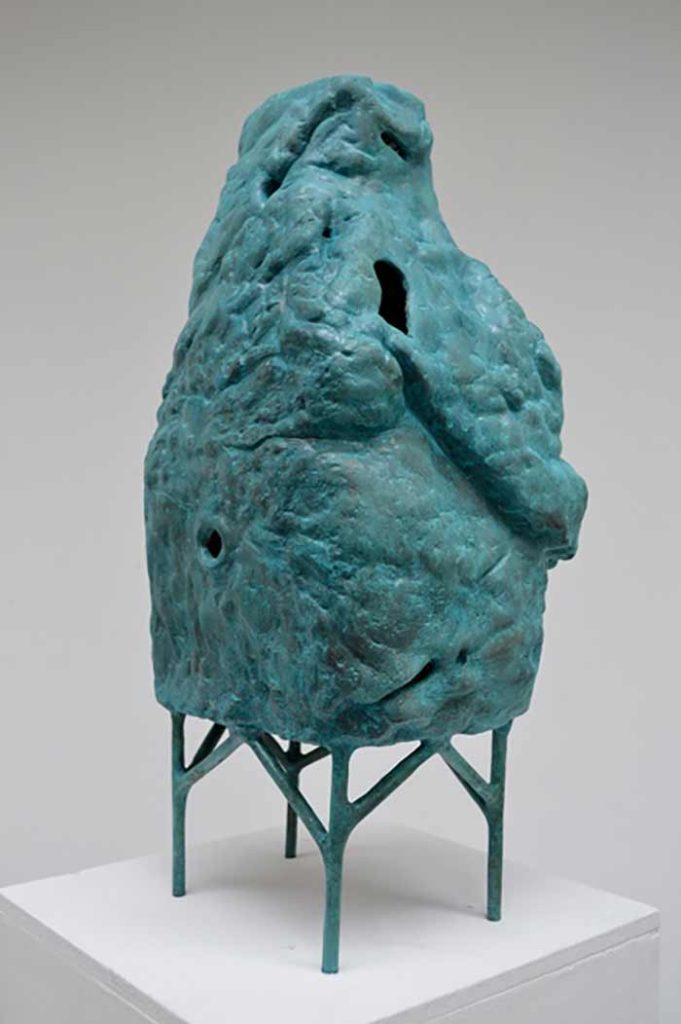
Lacuna. Contemporary artist Andrea Gregson.
What are you working on during this lockdown? How are you balancing life and work at home during the lockdown?
It is not always easy to balance home and work life, but I am used to this, being a mother, artist and University Lecturer; all parts of life have to fuse together. I have not been able to work in my studio during lockdown so have made small works on the kitchen table. Living in London during lockdown has created a sense of longing to be immersed in vast landscapes, of mountains, sea and lakes. It has brought about a new series of drawings called ‘Found Landscapes’ which depict craters, folds of matter, rock pools, mountains, caverns, geological structures and subterranean worlds. I also have been making another series called ‘Nightscapes’, which combine ink on graph paper with light. These chance images are places out of bounds, sometimes landscapes, seascapes, folly’s and caves.
What is there a crying need for in the art world today?
Many artists do not get paid for their work which is unsustainable. We need to make the art world more democratic, share the wealth around, be more transparent. Social media has increased artists visibility, yet artists often stop making art due to a lack of opportunities or networks. We need artists from different backgrounds to have a voice in the art world. We can see this through art history where whole groups of artists are written out of the narrative.

Solo show ‘Seeing Through The Ground’ Grizedale Forest Project Space (Room 2 – ‘Tallystick’ (ceiling) + ‘Flagrant Matter’ (floor) + ‘Lathe-Bed’ (wall), 2019. Contemporary artist Andrea Gregson.
What do you look for while viewing art? Which shows, performances and experiences have shaped your own creative process? Who are your maestros?
I spent two years living in Poland, working at the Academy of Fine Arts in Warsaw from 1995-97 as a Postgraduate Fellow. During this time, I was invited to group shows, met many interesting artists, curators and attended symposiums and arts events shaping my practice over the years. These events taught me the power of artists to change public life and space, enriching the world through meaningful content and generosity. It sparked my interest in collective histories, how artworks can manifest ideas through their historical context.
Similarly, I find artworks that relate to nature and human behaviour, which transcend their materiality, critically engaging. Installation and sculpture continues to fascinate me; the various ways in which the viewer can engage with space, objects, materials and ideas. In 2014, I collaborated with Gustav Metzger and others to curate the Facing Extinction Conference and Exhibitions and Remember Nature in 2015. This work examined how art and design can inform debates about species loss, climate change and extinction. Working with Gustav and other collaborators changed my art practice, galvanising the context of my ideas and work in relation to nature.
How do you balance the contradicting motivations: commercial v/s creative? How does your interaction with a curator, gallery or client evolve from the initial interface, to the working-involvement-relationship?
It is important to strike a balance between all forms of output and practice. Working with a brief is in-itself creative; how to interpret someone else’s input through the work. When I work with curators, I enjoy mutually creative conversations, their input can be a catalyst for the work, taking my research into new directions. I use this process as a creative place to shape the work, emerging from dialogue with sites and the people who work there.

Solo show ‘Seeing Through The Ground’ Grizedale Forest Project Space (Room 1 – ‘Carbon Delta’ (floor) + ‘Saw shed’ (right wall) + ‘Spectre’ (left wall). Contemporary artist Andrea Gregson.
What was your first sale? Do you handle the commercials yourself or is it outsourced to a gallery/agent?
The first sale was during my degree show at Bretton Hall, an art school formerly sited in the grounds of the Yorkshire Sculpture Park; a collector from Leeds purchased my bronze sculpture. I have sold works through shows in galleries and museums and applied for funding, commissions, residencies, competitions and open calls, most of which had funding or in-kind support attached to them. Being an artist has taught me to be careful with resources, space and money, how to make the most out of your situation whilst managing my art career alongside the making of the work. I have applied for funding and had some success setting up projects and shows, currently I am looking at new ways of selling editions of work.
Tell us about your studio, what kind of place is it? Could you describe your usual work-day in the studio?
My studio is situated in an industrial estate in South London among other artists and designers. It has a communal space which can be used to fabricate work, and there is a lot of generosity among the artists there. I share my studio with my partner Thomas Hylander, a Danish painter, our work creates mutual dialogue together in the space. I use the space to experiment with materials building conglomerates of waste matter; partial objects in play that fit together, a balancing act I call Objectships. Also work with clay, casting in porcelain, making moulds for waxes to be cast into metal at foundries, for constructions in wood, making sections for larger works and experimentation with other materials.
One such piece, ‘Crystal Haul’ expands upon the idea of future accretions of geology. Consisting of plastic fruit and vegetable nets; I have collected a large quantity of my own with the help of family and friends for this growing artwork.
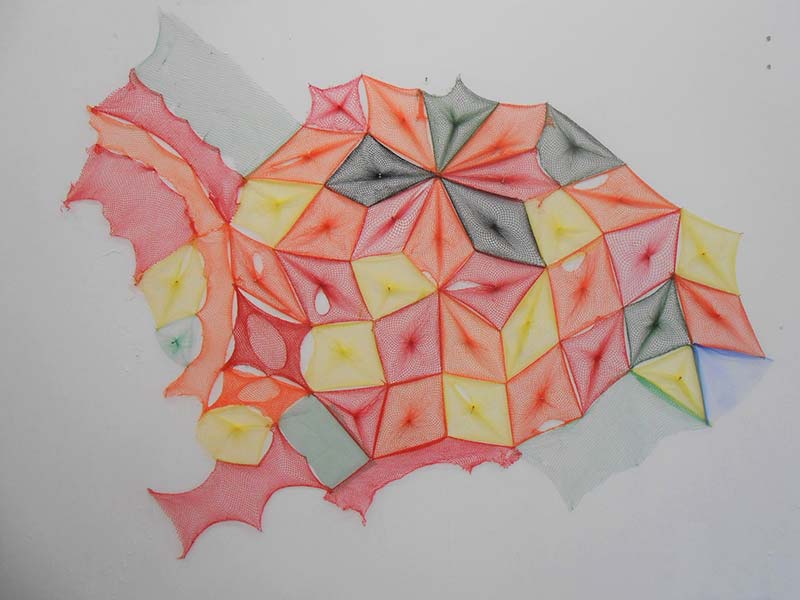
‘Crystal Haul’ 2016. Contemporary artist Andrea Gregson.
Are you more of a studio artist or naturally collaborative by nature? How do you feel about commissions?
Artists need to work in society not edged on the periphery. Being relevant in the art world, not just in your own network, but to a wider public. My work is multi layered and sometimes it can be studio based and other times adapted for a range of different sites. I am interested in all forms of collaboration that makes for good enriching research, talking to others, meeting groups of people with different knowledge and experience which I can bring to the work. For a recent residency in Grizedale Forest I met with curators, historians, museum staff, foresters and ecology organisations who shared their knowledge about local sites of interest. One such place was the Stoney Hazel Finery Forge, a ruin of an 18th century iron bloomery where I made a large-scale frottage drawing for the show.
At another medieval bloomery site, I made a wax casting of some local bedrock found in the stream which was later reconfigured into a cast iron sculpture titled ‘Carbon Delta’. Commissions are an interesting way to make work for new audiences and public spaces. I have made two versions of ‘Checkpoint’ a wood sculpture to view the landscape with a series of drawings inside and plan to make more in other locations. The viewing holes are placed at differing heights and animate the sculpture and draw visitors to look inside. The drawings give a non-linear view of the surroundings, for visitors to reflect on human industry and nature’s industry. The sculpture makes you aware of yourself in nature; it’s a curiosity, a space of stillness where visitors can have a unique experience for contemplation and observation.
The other iteration of ‘Checkpoint’ is placed on the border of Glisholme Forest and the E20, a motorway linking Fyn with Jutland and Sjaelland in Denmark. I was drawn to the beauty of the forest, the colour and scale, but such a startling contrast from the road. It acts as a folly for our times, for our geological era. Nearby, I also made another site-specific work, Korssting (cross-stich), the translation of the hand sewn text reads, “Silence is Compliance” on a 6 meter curtain hung in a damaged section of the forest. The needlework using the dimensions of the billboard, is a subtle act of defiance, re-appropriating this decorative motif to question our relation to nature. But the text is ubiquitous, relevant to many situations, speaking up for your beliefs.
Is there any topic you would like to be mentored on?
I would be keen to learn some digital programs like AutoCAD, to take my drawings into other design applications to work out installation and fabrication details for future works.
Before you go – you might like to browse our Artist Interviews. Interviews of artists and outliers on how to be an artist. Contemporary artists on the source of their creative inspiration.












Add Comment